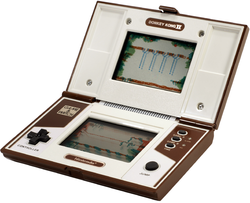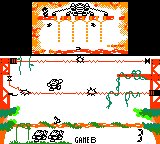Donkey Kong II: Difference between revisions
Tag: Rollback |
No edit summary Tags: Manual revert Disambiguation links |
||
| (9 intermediate revisions by 6 users not shown) | |||
| Line 1: | Line 1: | ||
{{italic title}} | {{italic title}} | ||
{{about|the Game & Watch game|uses of the term "Donkey Kong 2"|[[Donkey Kong 2]]}} | |||
{{game infobox | {{game infobox | ||
|title=Donkey Kong II | |title=Donkey Kong II | ||
| Line 5: | Line 6: | ||
|developer=[[Nintendo Research & Development 1]] | |developer=[[Nintendo Research & Development 1]] | ||
|publisher=[[Nintendo]] | |publisher=[[Nintendo]] | ||
|release=March 7, 1983 | |release=March 7, 1983<ref name=release>{{cite|deadlink=y|archive=web.archive.org/web/20220412003002/http://www.intheattic.co.uk/donkey_kong_ii.htm|title=''Donkey Kong II''|publisher=In The Attic|accessdate=May 17, 2024}}</ref> | ||
|genre=[[Genre#Platform games|Platformer]] | |genre=[[Genre#Platform games|Platformer]] | ||
|ratings=N/A | |ratings=N/A | ||
|modes=Single player | |modes=Single player | ||
|platforms=[[Game & Watch]] | |platforms=[[Game & Watch]] | ||
| | |format={{format|gaw=1}} | ||
|input={{input|gaw=1}} | |input={{input|gaw=1}} | ||
|serials=JR-55 | |||
}} | }} | ||
'''''Donkey Kong II''''' is a [[Game & Watch]] game released as part of the Multi Screen series on March 7, 1983.<ref | '''''Donkey Kong II''''' is a [[Game & Watch]] game released as part of the Multi Screen series on March 7, 1983.<ref name=release/> It was later rereleased as part of ''[[Game & Watch Gallery 3]]''. It is an indirect sequel to the ''[[Donkey Kong Jr. (Game & Watch)|Donkey Kong Jr.]]'' Game & Watch game and a direct follow-up to ''[[Donkey Kong (game)|Donkey Kong]]''. While ''Donkey Kong Jr.'' is based on the first level of the [[Donkey Kong Jr. (game)|arcade game of the same name]], ''Donkey Kong II'' appears to be based on the [[Mario's Hideout|third level]] and [[Chain Scene|fourth level]]. This game, ''Donkey Kong Jr.'', and ''[[Donkey Kong Circus]]'' are the only times where [[Mario]] has ever been portrayed as an antagonist. | ||
[[File:Donkey Kong II JR-55 Bell1.gif|thumb|left|The alarm bell]] | [[File:Donkey Kong II JR-55 Bell1.gif|thumb|left|The alarm bell]] | ||
| Line 55: | Line 57: | ||
[[Category:Platforming games]] | [[Category:Platforming games]] | ||
[[Category:Donkey Kong series]] | [[Category:Donkey Kong series]] | ||
[[Category:Game & Watch Gallery | [[Category:Game & Watch Gallery 3 minigames]] | ||
[[de:Donkey Kong II]] | [[de:Donkey Kong II]] | ||
[[it:Donkey Kong II]] | [[it:Donkey Kong II]] | ||
Latest revision as of 04:18, November 13, 2024
- This article is about the Game & Watch game. For uses of the term "Donkey Kong 2", see Donkey Kong 2.
| Donkey Kong II | |
|---|---|

| |
| Developer | Nintendo Research & Development 1 |
| Publisher | Nintendo |
| Platform(s) | Game & Watch |
| Release date | March 7, 1983[1] |
| Genre | Platformer |
| Rating(s) | N/A |
| Mode(s) | Single player |
| Format | Game & Watch:
Built-in
|
| Input | Game & Watch:
|
| Serial code(s) | JR-55 |
Donkey Kong II is a Game & Watch game released as part of the Multi Screen series on March 7, 1983.[1] It was later rereleased as part of Game & Watch Gallery 3. It is an indirect sequel to the Donkey Kong Jr. Game & Watch game and a direct follow-up to Donkey Kong. While Donkey Kong Jr. is based on the first level of the arcade game of the same name, Donkey Kong II appears to be based on the third level and fourth level. This game, Donkey Kong Jr., and Donkey Kong Circus are the only times where Mario has ever been portrayed as an antagonist.
The alarm indicator of this game is a bell that is located beside the leftmost lock, and Mario strikes the bell with a drumstick when the alarm goes off.
Story[edit]
Essentially, this game contains the same story as Donkey Kong Jr.—Donkey Kong is trapped by Mario, and now Donkey Kong Jr. must save him.
Gameplay[edit]
Donkey Kong is chained to the floor on the top of the upper screen by several locks. Donkey Kong Jr. must hit a key up to the top screen and then progress through the bottom screen, jumping over Snapjaws and Sparks much as Mario jumped over barrels in Donkey Kong. Every time Donkey Kong Jr. jumps over a Snapjaw or Spark, he receives a point. When he reaches the top screen, he must hit the key right next to one of the locks, avoiding birds along the way, then climb up the chain that trails below the lock. Once he reaches the top, he uses the key to open the lock, earning from five to fifteen points depending on how fast he does the job. Then, he must progress back down to the bottom to hit a new key up, and so on. When Donkey Kong Jr. opens all four locks, he frees Donkey Kong, awarding the player 20 points. If Donkey Kong Jr., after opening a lock, has no misses when he returns to the starting position and throws up a key, he earns five points. If a Snapjaw, bird, or Spark hits Donkey Kong Jr., he loses a life, and the key returns to the starting position. If Donkey Kong Jr. reaches 300 points without any misses, the points are worth double until he does get a miss. If he has any misses at said score, he receives an extra life instead. The game ends when he loses three lives.
In Game A, the Snapjaws and birds on the upper screen disappear when Donkey Kong Jr. places the first key into the lock, with only the bird in the upper left corner and the Snapjaw in the lower right corner remaining. In Game B, however, the Snapjaws and birds remain when Donkey Kong Jr. places a key into the lock, making it more difficult for him to return.
Controls[edit]
: Move
: Jump
: Switch "main" screen
Gallery[edit]
A sprite of Donkey Kong
A sprite of Mario
References[edit]
- ^ a b Donkey Kong II. In The Attic. Archived April 12, 2022, 00:30:02 UTC from the original via Wayback Machine. Retrieved May 17, 2024.
| Game & Watch games | ||
|---|---|---|
| Super Mario franchise | Donkey Kong (1982, MS) • Mario Bros. (1983, MS) • Mario's Cement Factory (1983, TT/NWS) • Mario's Bombs Away (1983, PS) • Donkey Kong Hockey (1984, MVS) • Super Mario Bros. (1986, CrS | 1987, Sp | 1988, NWS) • Mario the Juggler (1991, NWS) • Game & Watch: Super Mario Bros. (2020, CoS) | |
| Donkey Kong franchise | Donkey Kong (1982, MS) • Donkey Kong Jr. (1982, NWS | 1983, TT & PS) • Donkey Kong II (1983, MS) • Donkey Kong 3 (1984, MVS) • Donkey Kong Circus (1984, PS) • Donkey Kong Hockey (1984, MVS) | |
| Miscellaneous | Green House (1982, MS) | |
| MS: Multi Screen • TT: Table Top • PS: Panorama Screen • NWS: New Wide Screen • MVS: Micro VS. System • CrS: Crystal Screen • Sp: Special • CoS: Color Screen | ||
| Game & Watch Gallery series | ||
|---|---|---|
| Games | Game & Watch Gallery (1997, GB) • Game & Watch Gallery 2 (1997, GB) • Game & Watch Gallery 3 (1999, GBC) • Game & Watch Gallery 4 (2002, GBA) | |
| Super Mario minigames | Donkey Kong2,4 • Donkey Kong Jr.3,4 • Donkey Kong II3 • Donkey Kong 34 • Mario Bros.3,4 • Mario's Bombs Away4 • Mario's Cement Factory4 | |
| Minigames remade with Super Mario content |
Ball2 • Boxing4 • Chef2,4 • Egg3 • Fire1,4 • Fire Attack4 • Greenhouse3 • Helmet2 • Manhole1 • Octopus1,4 • Oil Panic1 • Parachute2 • Rain Shower4 • Turtle Bridge3 • Vermin2 | |
| Gallery Corner | Message Board • Museum • Music Room | |
| Further info | Gallery (2 · 4) • Pre-release and unused content (4) • Staff (2 · 3 · 4) | |
| Related game | Game & Watch Collection | |


